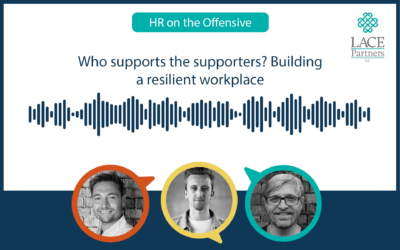In this week’s blog we hear from LACE Partners CEO and Co-Founder Aaron Alburey on a topic never far from the HR Director’s agenda: attrition. He shares trends over time and discusses how you can get balance right between retaining talent and corporate memory but also bringing fresh ideas into the business.
As trends come and go and economic cycles are lived through, the question of “what is acceptable attrition?” has changed and adapted. So, what is it now, what should businesses focus on and what should HR be promoting?
Let’s start with the myth that “all attrition is bad”. No, it isn’t. In fact, attrition is natural, allowing for new blood to enter your business, to bring new knowledge, innovation, diversity and challenge. We see it time and again with clients where attrition levels are low; they engage us because their own teams don’t have relevant external experience anymore to drive the change the business needs.
Likewise, high attrition is also not good, although we have seen companies and whole industry sectors lulled into a false sense of what is right, to avoid holding the mirror up and looking at the underlying reasons for attrition. “Oh, that’s the industry norm!”, “we always have high attrition at this time of year”, or one of my favourites “attrition is healthy for us as it makes promotions easier”.
I have personally worked in businesses with over 30% attrition in which the leadership team justified as normal for the sector. It isn’t because it impacts the ability to pass on knowledge to the business, because you lose not just the talent, but also their experience and knowledge. To bring the impact of that home, with over 30% attrition in your business, every three years, you could have lost all your knowledge completely. As important as it is to bring in new points of view is to a business, so is retaining corporate memory.
Corporate memory
Corporate memory – or organisational memory – is the accumulated body of knowledge created in the course of an organisation’s existence. It includes the processes, ways of working and know-how for every task of every employee. Reducing the impact of ‘corporate memory loss’ is critical not only for efficiencies, but it also has a part to play in ensuring employees feel part of the team.
In this competitive talent environment, all organisations are doubling their efforts for smooth candidate and onboarding experiences; which can be dampened by lack of robust information for new starters. A clear handover and defined expectations from the beginning can make a huge difference. At LACE, we tackle this in a number of ways including internal webinars and also digital enablers like Method Grid. We use this as a shared knowledge base and process development tool, creating a repository of experience-based information.
Finally, it’s important to factor in the cost of attrition. Every attrition replacement can cost a business up to five times the annual salary of that individual in recruitment fees, interview and management time, training and lost revenue and productivity. Getting this right is one of the biggest strategic value levers that the HR and the People function can directly influence and control.
Attrition norms
When I spoke to my team about what they saw as rough industry norms (this is a team with collectively over 100 years of Big Four consulting experience, so we’ve got a good grounding based on clients we’ve all worked with pre-LACE and whilst at LACE) our collective team experience was pretty aligned on the norms by industry that we have experienced over the years, these include:
- Consulting >25% is normal
- Retail (front line) – 30%
- Insurance <15%
- Oil and Gas <15%
- Technology > 20%
- Consumer Goods <10%.
Of course, this fluctuates and will vary, so you should only take this as experiential knowledge rather than coming from a quantitative set of research results, but in our experience, this is what most businesses in these sectors experience.
What is acceptable in that range between too low and too high?
In our experience, we would recommend 10-15% attrition to allow for continuous evolution of skills and capability and for the departure of those not performing – without stripping your cumulative knowledge and capability or raising operating costs. Over the years we have seen organisations and HR functions take differing approaches to this, in the case of institutional low attrition organisations can introduce a forced attrition, typically based around performance and contribution.
Skills based attrition
What is interesting however, is the fact that sector attrition means nothing compared to workforce and skills-based attrition rates. We have seen pre – and now accelerated post–Covid – a flip to a skills and capabilities focus.
These skills cut across industry, and include job titles such as software engineers, sustainability engineers etc. Within these skill-ecosystems there are emerging spikes of attrition as people in these in demand groups follow the acquisition of skills, interesting work and increasing pay.
Advice for HRO’s
As HR professionals, we should understand the make-up of our businesses and define acceptable attrition rates – not just for our business but also for these critical workforces and develop our plans accordingly.
One thing we have learnt over the years is that just because everyone else in your industry suffers from high attrition, doesn’t mean you need to. Set your own course. Establish your purpose, your employee value proposition (EVP) and your acceptable and required levels of attrition.
One thing is for sure, not having a strategy to manage and address attrition nor focusing on the impact of this in your business is foolish in this current employment environment.
Interested in talking to us about your strategy for ensuring you get the right level of attrition? Get in touch and we’ll get in touch with you about your people strategy plans.






